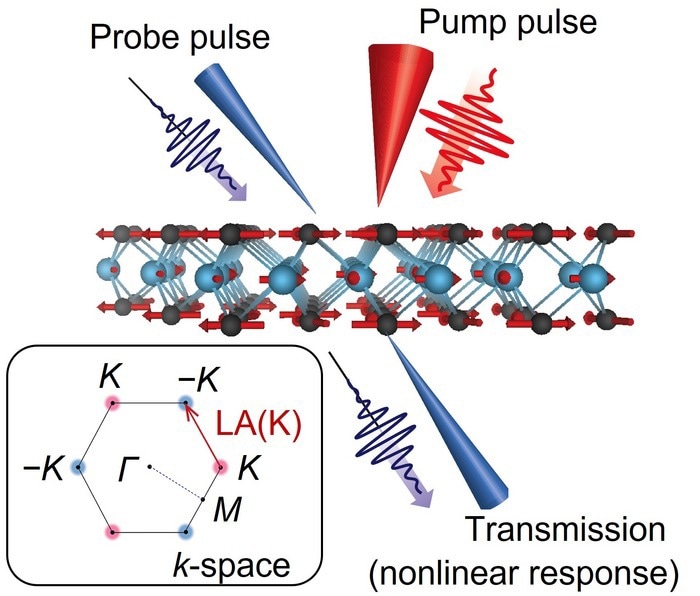Tiny materials conceal enormous secrets, the answers to which could pave the way for next-generation electronics. A multinational team led by Japanese researchers solved the mystery of cryptic overtone signals in an investigation of molybdenum diselenide, an atomically thin crystal lattice with desired features distinct from its bulkier three-dimensional form.
 By exciting the transitional metal dichalcogenide monolayers—atomically thin semiconductors—with ultrashort pump pulses, atoms can coherently vibrate and modulate optical responses. The probe pulses can detect the ultrafast modulation that shows peculiar high-frequency overtones of K-point acoustic phonons. Image Credit: Yokohama National University.
By exciting the transitional metal dichalcogenide monolayers—atomically thin semiconductors—with ultrashort pump pulses, atoms can coherently vibrate and modulate optical responses. The probe pulses can detect the ultrafast modulation that shows peculiar high-frequency overtones of K-point acoustic phonons. Image Credit: Yokohama National University.
The researchers published their findings in Nature Communications on July 25th, 2022.
The compound belongs to a class of two-dimensional semiconductors known as transitional metal dichalcogenide (TMD) monolayers, all of which exhibit electronic band structures with valleys. TMD lattices are hexagonal in shape, with the appropriate wavevector, known as k-space, running along the side. The “M point” is the side center point of the k-space, while the six corners are known as “K (-K) points.”
The valleys are the dips and peaks in the electronic band at the hexagonal corners, where energy or information-carrying particles can flow and tip the material into activity. However, the intervalley actions, particularly those associated with electron scattering, have remained elusive. In this process, phonons, or energy units exhibited as vibrations, force electrons to spread and transition states in the intervalley space at an extremely fast rate.
According to co-corresponding author Soungmin Bae, a postdoctoral researcher in the Laboratory for Materials and Structures at the Tokyo Institute of Technology, if valley polarization can be governed to stimulate or reduce specific properties, TMDs are the most promising candidate for advanced technologies. The name of this niche field is derived from the combination of valley and the potential for electronics: valleytronics.
To establish the fundamental understanding of ultrafast dynamics associated with phonon-mediated intervalley scattering processes, we performed pump-probe spectroscopy using sub-10-femtosecond—10-quadrillionth of a second—ultrashort pulsed lasers and found interesting overtone signals of acoustic phonons in the optical modulation.
Soungmin Bae, Postdoctoral Researcher, Laboratory for Materials and Structures, Tokyo Institute of Technology
Soungmin Bae adds, “The signals were already well-known in the TMDs community, but the origin was unclear, so our original question we aimed to answer was, ‘why do we observe such overtone signals?”
Pump-probe spectroscopy involves irradiating a TMD sample in two portions using an ultrashort laser pulse. The pump is a powerful beam that excites the TMD, causing the system to oscillate in the same way that throwing a stone into a pond produces concentric waves.
The probe is a weaker beam that records the temporal evolution of the produced oscillations—the waves of lattice vibrations, also known as phonons—by observing changes in the system’s optical constants, such as absorption and reflection.
Several signals, visible as optical modulations, were observed by the researchers at both even and odd orders of phonon oscillations from the monolayer TMD.
They examined the phonon symmetry and used first-principles calculations— or supercomputer-powered assessments that define the quantum mechanical state and dynamics of each and every nucleus and electron in the system, from which information on various components can be extracted.
The observations revealed that only the longitudinal acoustic phonon at the K point could produce the observed odd-order signal because it modulated the laser light asymmetrically, unlike the M-point phonon.
K-point longitudinal acoustic phonons are responsible for ultrafast intervalley scattering in monolayer molybdenum diselenide. Normally K-point phonons could not modulate the optical properties because of the large mismatch between the wavevector—the direction and magnitude—of the incident light and that of the phonons.
Jun Takeda, Study Co-Corresponding Author and Professor, Graduate School of Engineering Science, Yokohama National University
According to Takeda, in TMDs, the great symmetry of the two-dimensional crystal lattice permits K-point acoustic phonons to control the optical response and generate signals at different frequencies.
This work proves the importance of combined approach of ultrafast spectroscopy with symmetry analysis and first-principles calculations for unveiling the underlying physics of intervalley scattering process in valleytronic materials.
Ikufumi Katayama, Study Co-Corresponding Author and Professor, Graduate School of Engineering Science, Yokohama National University
“Next, we would like to extend these approaches to other exotic two-dimensional material systems for future electronic and valleytronic applications and to establish ways to manipulate the optical and physical properties at ultrafast timescales.”
Bae is also associated with the Graduate School of Engineering Science at Yokohama National University.
Kana Matsumoto, Hannes Raebiger, Ken-ichi Shudo, and Masahiro Kitajima, Graduate School of Engineering Science, Yokohama National University; Yong-Hoon Kim, School of Electrical Engineering, Korea Advanced Institute of Science and Technology (KAIST) in Korea; Xiang Zhang, Robert Vajtai, Pulickel Ajayan, and Junichiro Kono, Rice University in the United States also contributed to the study.
Other contributors include Ørjan Sele Handegård, Tadaaki Nagao, and Kitajima International Center for Materials Nanoarchitectonics, National Institute for Materials Science; and Yuji Sakai, Institute of Laser Engineering, Osaka University. Sele Handegård, and Nagao are also affiliated with the Department of Condensed Matter Physics, Graduate School of Science, Hokkaido University.
The Japan Society for the Promotion of Science, the Mitsubishi Foundation, the Robert A. Welch Foundation, the Iwaki Scholarship Foundation, the Yokohama Kogyokai, and Yokohama National University Rector’s strategic funding supported this study.
Journal Reference:
Bae, S., et al. (2022) K-point longitudinal acoustic phonons are responsible for ultrafast intervalley scattering in monolayer MoSe2. Nature Communications. doi.org/10.1038/s41467-022-32008-6.